Letter knowledge
Children will identify and say the name and sound of selected letters.


Review:

Be Prepared: Use results of the Week 43 letter assessments and your knowledge of children’s letter knowledge to select 4–6 letters that would be helpful for children to review. Gather letter cards and uppercase letter manipulatives for the selected letters. Be sure letters are formed in the same manner in the letter manipulatives and on the letter cards. Place one set of the letter manipulatives in a small cup for each child. Today’s activity is a variation of earlier use of letter mats and letter manipulatives (Language/Literacy Week 12, Day 4).
Another option for today’s activity is to reintroduce selected letters using the activity plans in which the letters were presented. See the Sequence of Skills and Learning Goals chart in the ELM Curriculum User Guide: 3–5 Years for a quick guide to when letters were initially introduced.
Provide children with blank letter mats and markers. Display letter cards, one at a time. Say the name of the letter. Invite children to say the name of the letter. Example: “This is the letter G. Let’s all say its name.” Say the sound that the letter makes and a word that starts with the letter. Invite children to say the sound the letter makes. Example: “The letter G makes the sound /g/, like in the word ‘goat.’ Lets’ together say the sound of the letter G: /g/.”
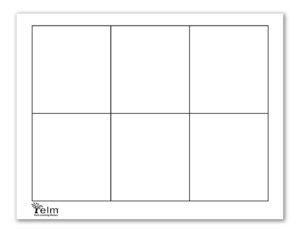 Demonstrate how to write the letter. Invite children to write the letter in one of the boxes on their letter mat. (There will be two empty boxes if four letters are used instead of six.) Children may wish to use the letter card as a reference. Encourage children to write both the uppercase and lowercase forms of the letter.
Demonstrate how to write the letter. Invite children to write the letter in one of the boxes on their letter mat. (There will be two empty boxes if four letters are used instead of six.) Children may wish to use the letter card as a reference. Encourage children to write both the uppercase and lowercase forms of the letter.
After children have written all selected letters on their mats, give each child a cup of letter manipulatives. Invite children to match letter manipulatives and the letters they wrote on their mat. Display the letter card as a visual reminder of the letter.
Number knowledge
Children will practice counting to a target number.


Review:
Offer the Week 11, Day 4 activity to review how to count to a target number.
 Offer a game in which children practice counting to a target number.
Offer a game in which children practice counting to a target number.
Be Prepared: Gather four cards for each of the following numerals: 1, 2, 3, 4, and 5 (total: 20 cards). Put the cards in random order in one stack.
Place the two tracks side by side, in the middle of the group of children. Show the two car counters. Place one car counter at the beginning of each track. Explain that we will work together to help the car counters reach the end of the track. Display 2–3 small numeral cards, one at a time, and lead children in naming each numeral and counting the number of dots on each card. Place the stack of randomly-organized cards face down near the starting points of the two tracks.
Demonstrate how to play by drawing a card from the top of the stack and naming the numeral. Move one car the number of spaces equal to the numeral on the card. Count aloud each space on the track as the car counter touches it. Point out that you stopped moving the car counter after you moved it the number of spaces shown on the card. Conclude your demonstration by returning the car counter you moved to the starting point for a child to use in the game.
Invite a child to draw a small numeral card and name the numeral. Encourage the child to move one of the car counters the number of spaces equal to the numeral on the card he/she drew. Invite another child to repeat the process, this time moving the other car. Continue playing the game by inviting each child, one at a time, to draw a small numeral card and move a car counter the number of spaces shown on the card. Children alternate moving the first or second car.
If all children have not had an opportunity to draw a small numeral card when one car counter reaches the end of the track, move both car counters to the starting line and start the game again.
Executive function
Children will understand how to focus on facial expressions of others.


Review:
Be Prepared: If time permits, offer It’s Raining, It’s Pouring from Week 48, Day 2 as a second game. If the game described below is too challenging for a majority of children, stop at an appropriate place and offer It’s Raining, It’s Pouring from Week 48, Day 2. The game for today may be less challenging when offered again at a later point.
[Arrange children so they are sitting in a circle on the floor.]
We are learning about many different emotions. We know what it means to feel silly. Remember, we feel happy and playful when we feel silly. Let’s all show our silly faces!
Today we are going to sing a song we’ve sung before. It’s the “Silly Faces Song.”
What do we do when we sing the “Silly Faces Song”?
Each of us will get a turn to make a silly face while we sing the “Silly Faces Song.” We know there are many different types of silly faces we can make!
Now (adult helper) and I are going to sing the song first to remind you of what to do.
[The “Silly Faces Song” is sung to the tune of “Mary Had a Little Lamb.” Sing the following song using the adult helper’s name:]
“_____ make a silly face, silly face, silly face. _____ make a silly face, watch and copy her!”
[Invite children to imitate the adult helper’s silly face.]
Remember, each time we sing the song, we will use the name of a different child in our circle. The child we name will make a silly face, and then the rest of us will copy the silly face. We need to make sure we are paying attention, so we know what kind of silly face to make. Remember, we need to wait patiently for our turn. If you do not wish to make a silly face when it is your turn, just say “no thank you.”
Let’s try it together!
[Lead children in singing the song as you move around the circle from child to child. As each child takes his/her turn making a silly face, encourage the other children to imitate the silly face.
If a child chooses not to make a silly face, that is okay. Move to the next child in the circle. Continue until you have sung each child’s name. If children who did not initially want to make a silly face wish to do so after all other children have gone, invite them to do so.]
Now we are going to change our song a little. This time we are going to call our song the “Angry Faces Song.” When we sing the “Angry Faces Song,” we will each get a turn to make an angry face. Show us your angry face! Let’s try it!
[Lead children in singing the song as you move around the circle from child to child. As each child takes his/her turn making an angry face, encourage the other children to imitate the angry face.
If a child chooses not to make an angry face, that is okay. Move to the next child in the circle. Continue until you have sung each child’s name. If children who did not initially want to make an angry face wish to do so after all other children have gone, invite them to do so.]
[If time permits:]
Now we are going to change our song one more time. This time we are going to call our song the “Surprised Faces Song.” When we sing the “Surprised Faces Song,” we will each get a turn to make a surprised face. Show us your surprised face! Let’s try it!
[Lead children in singing the song as you move around the circle from child to child. As each child takes his/her turn making a surprised face, encourage the other children to imitate the surprised face.
If a child chooses not to make a surprised face, that is okay. Move to the next child in the circle. Continue until you have sung each child’s name. If children who did not initially want to make a surprised face wish to do so after all other children have gone, invite them to do so.]
Today we practiced paying attention to other children and copying someone else’s silly, angry, and surprised face!
Extra support
Enrichment
Encourage children to continue the “Angry Faces Song” or “Surprised Faces Song.” Invite children to change the song to include options other than making an angry or surprised face. Examples: doing an angry/surprised dance or moving in an angry/surprised way.
Sing the “Angry Faces Song” or “Surprised Faces Song” while outside. Encourage children to mimic each other’s expressions while playing on the swings or playing with a ball.
Knowledge of creative processes, Skills that support creative expression
Children will understand ways artists can share information about their artwork with people who attend an art exhibition.


New:
Review:

Be Prepared: Arrange for another adult to help you support children in putting information on a label that describes their artwork.
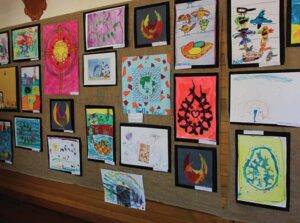 Beginning tomorrow we will have an exhibition of art created by children in our room! Yesterday each of us picked one piece of art we want to include in our exhibition. We are inviting families and people at our center to attend the exhibition.
Beginning tomorrow we will have an exhibition of art created by children in our room! Yesterday each of us picked one piece of art we want to include in our exhibition. We are inviting families and people at our center to attend the exhibition.
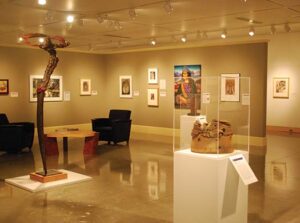
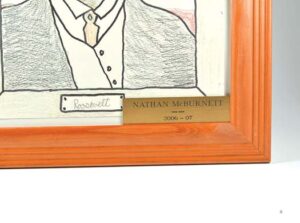 People who attend the exhibition will want to know about the art we put on display. In an exhibition, usually each work of art has a label. A label tells people looking at the art something about the artist and the artwork.
People who attend the exhibition will want to know about the art we put on display. In an exhibition, usually each work of art has a label. A label tells people looking at the art something about the artist and the artwork.
[Point out labels in two exhibition pictures.
Display picture of a label and point to the label as you read it.]
This is a picture of a label. This label tells us who the artist is and when the art was created. Many times the artwork has a title.
What else has titles? (books)
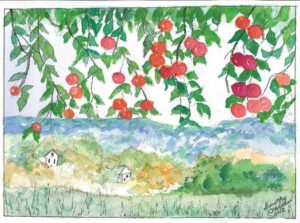 There is another way we often can tell who created the art. Most artists sign their name on their art.
There is another way we often can tell who created the art. Most artists sign their name on their art.
[Display picture of signed artwork.]
Here is a picture of a painting. If we look closely at the bottom of the painting, we can see where the artist signed her name.
Why do you think artists sign their art? (so people know who created the art)
Let’s each use a note card to write our name. Please write as much of your name as you can. You may want to give your artwork a title. Your title can be short, like “a tree” or “my baby brother” or “my house.” (Name of other classroom adult) and I can help you put a title on your label, if you wish. We also will add the year you create your artwork.
You may want to put your name on your piece of art. Usually the artist’s name goes at the bottom of the artwork.
[Distribute note cards and writing tools. Provide appropriate assistance to children in preparing a label for their art. Collect artwork and labels for hanging.
If time permits, show children the space where artwork will be displayed.]
Today we learned how artists can share information about their artwork. Art that is in an exhibition often has a label that tells the name of the artist, the year the artwork was done, and sometimes the title of the artwork. We made labels for our artwork. People who attend our art exhibition can learn about our art by reading a label and looking at our work.
Extra support:
Enrichment:
Provide materials for children to continue working on their labels. Invite several volunteer children to help you hang or display the artwork.
Take a walk around the neighborhood and look for art. Use a similar chart labeled Art in Our Neighborhood to record what is found.